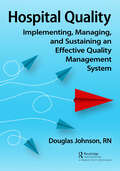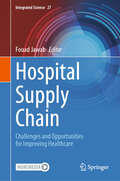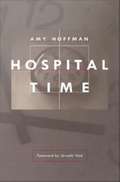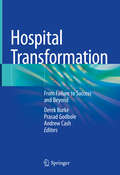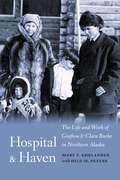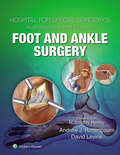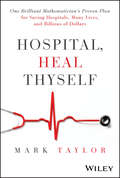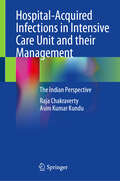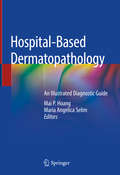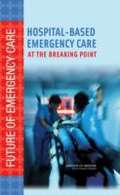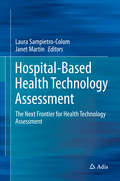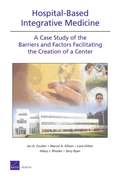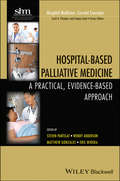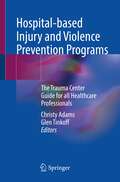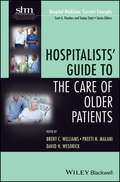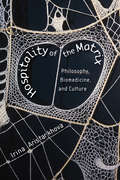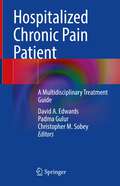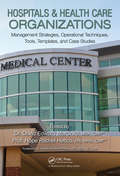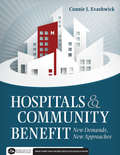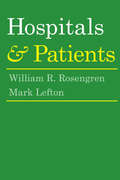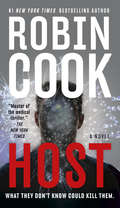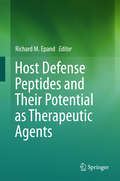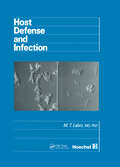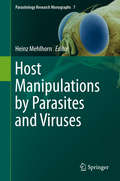- Table View
- List View
Hospital Quality: Implementing, Managing, and Sustaining an Effective Quality Management System
by Doug JohnsonIn healthcare, quality management refers to the administration of systems design, policies, and processes that minimize, if not eliminate, harm while optimizing patient care and outcomes. Whether you are a hospital with 1,000 beds or 25, the fact remain that every hospital must navigate and manage the many complexities associated with a quality management system. Why is quality management important in healthcare? There are numerous reasons why it is important to improve quality of healthcare, including enhancing the accountability of health practitioners and managers, resource efficiency, identifying, and minimizing medical errors while maximizing the use of effective care and improving outcomes, and aligning care to what users and patients want in addition to what they need. Hospital Quality: Implementing, Managing, and Sustaining an Effective Quality Management System demonstrates a practical approach to managing and improving quality. Whether you agree with the premise that these activities are complex, this book will outline a standardized approach that any organization can adopt to meet their needs while accommodating the foundational concepts of quality improvement by accreditation agencies. It also outlines how to set-up and manage a quality management program as a part of continuous process improvement initiative, as well as the purpose and managing of a patient safety organization. The purpose of this book is twofold. If you’re a senior healthcare manager or director tasked with setting up a quality management system, this book will provide tools and techniques you can immediately apply. If you’re a healthcare professional preparing for the CPHQ certification exam, this book will take you beyond study guides by explaining what you need to know and the why behind each concept.
Hospital Supply Chain: Challenges and Opportunities for Improving Healthcare (Integrated Science #27)
by Fouad JawabThis book provides a comprehensive and essential resource for healthcare professionals, researchers and students interested in the field of hospital logistics. Hospital logistics is a complex process encompassing a wide range of design, planning, and execution activities, providing essential support for the production of healthcare services in all their forms. It is at once strategic, tactical and operational. Its scope ranges from the design and implementation of care units and healthcare facility networks, to the procurement of expensive drugs and medical equipment, the planning of human and material resources (beds, operating theaters, transport, etc.), and the management of stocks of drugs, blood and other health products. The role of hospital logistics is essential in guaranteeing the accessibility, quality and efficiency of care. It helps to optimize care production processes, reduce costs and improve workflow management. It offers an in-depth exploration of the key issues, best practices and technological advances in this critical field.
Hospital Time
by Amy HoffmanHospital Time is a memoir about friendship, family, and caregiving in the age of AIDS. Amy Hoffman, a writer, lesbian activist, and former editor of Gay Community News, chronicles with fury and unflinching honesty her experience serving as primary caretaker for her friend and colleague, Mike Riegle, who died from AIDS-related complications in 1992. Hoffman neither idealizes nor deifies Riegle, whom she portrays as a brilliant man, devoted prison rights activist, and very difficult friend. Hoffman became central to Riegle's caregiving when he asked her to be his health-care proxy, and although she willingly chose to do this, she explores her conflicting feelings about herself in this role and about her involvement with Riegle and his grueling struggle with hospitalization, illness, and, finally, death. She tells of the waves of grief that echoed throughout her life, awakening memories of other losses, entering her dreams and fantasies, and altering her relationships with friends, family, and even total strangers. Hoffman's memoir gives voice to the psychological and emotional havoc AIDS creates for those in the difficult role of caring for the terminally ill and it gives recognition to the role that lesbians continue to play in the AIDS emergency. A foreword by Urvashi Vaid, former executive director of the National Gay and Lesbian Task Force, offers a meditation on the politics of AIDS and the role of family in the lives of lesbians and gay men.
Hospital Transformation: From Failure to Success and Beyond
by Prasad Godbole Derek Burke Andrew CashThis book discusses the factors that contribute to the success of hospitals from a theoretical, practical and operational perspective to allow hospital managers both clinical and non-clinical at all levels to achieve success via a turnaround process where necessary. A robust performance management framework is detailed to make this success sustainable. Case studies where appropriate support the relevant chapters. Chapters can be read sequentially or as a stand-alone chapter. Hospital Transformation: From Failure to Success and Beyond enables readers to develop their hospital management skills. Issues of patient care, resource allocation, staff management, leadership, risk management, infection control, and financial sustainability are all covered. This book is relevant to hospital administrators, clinicians involved in hospital management, independent consultants, and healthcare providers responsible for day to day operations of healthcare facilities.
Hospital and Haven: The Life and Work of Grafton and Clara Burke in Northern Alaska
by Mary F. Ehrlander Hild M. PetersHospital and Haven tells the story of an Episcopal missionary couple who lived their entire married life, from 1910 to 1938, among the Gwich&’in peoples of northern Alaska, devoting themselves to the peoples&’ physical, social, and spiritual well-being. The era was marked by great social disruption within Alaska Native communities and high disease and death rates, owing to the influx of non-Natives in the region, inadequate sanitation and hygiene, minimal law enforcement, and insufficient government funding for Alaska Native health care. Hospital and Haven reveals the sometimes contentious yet promising relationship between missionaries, Alaska Natives, other migrants, and Progressive Era medicine. St. Stephen&’s Mission stood at the center of community life and formed a bulwark against the forces that threatened the Native peoples&’ lifeways and lives. Dr. Grafton (Happy or Hap) Burke directed the Hudson Stuck Memorial Hospital, the only hospital to serve Alaska Natives within a several-hundred-mile radius. Clara Burke focused on orphaned, needy, and convalescing children, raising hundreds in St. Stephen&’s Mission Home. The Gwich&’in in turn embraced and engaged in the church and hospital work, making them community institutions. Bishop Peter Trimble Rowe came to recognize the hospital and orphanage work at Fort Yukon as the church&’s most important work in Alaska.
Hospital for Special Surgery's Illustrated Tips and Tricks in Foot and Ankle Surgery
by David LevineLooking for real-world surgical advice traditional textbooks often leave out? This heavily illustrated first volume of a brand-new series is a compendium of surgical wisdom from veteran attending surgeons passed on to fellows, residents, and students. Guidance is contextualized to the contributor’s surgical field and facility or hospital, and chapters cover injuries (including sports injuries), deformities, chronic conditions, and more. A concise package of hints for surgical success!
Hospital, Heal Thyself: One Brilliant Mathematician's Proven Plan for Saving Hospitals, Many Lives, and Billions of Dollars
by Mark TaylorProven solutions to transform a healthcare system in crisis Part biography and part clear-eyed examination of a healthcare system in crisis, Hospital, Heal Thyself: One Brilliant Mathematician's Proven Plan for Saving Hospital, Many Lives. and Billions of Dollars tells the story of enigmatic healthcare visionary Eugene Litvak, whose research and strategies have already been implemented at many top 12-ranked hospitals to save hundreds of millions of dollars and countless thousands of patient lives. While U.S. healthcare costs continue to skyrocket, Litvak's program described in this book offers tested, effective methods to trim those costs while simultaneously improving patient outcomes. Written by veteran prize-winning healthcare journalist Mark Taylor, this book includes compelling discussion on: How hospital and emergency room overcrowding has harmful and potentially deadly effects on patients and staff How Litvak's algorithms and complex mathematical theories help hospitals staff appropriately to safely manage patient flow How applying Litvak's unique patient flow interventions improves nurse retention in an era of mass nurse exodus Litvak's methods have been proven to work in the best hospitals in America and the world. Studies in the top medical journals confirm their success in reducing medical errors; hospital and emergency room overcrowding; nurse and physician burnout and stress and patient mortality rates. They've saved millions of dollars for each hospital adopting them, while improving patient satisfaction and outcomes, nurse retention, hospital efficiency and addressing healthcare disparities and inequities. Distilling complex ideas into accessible language, Hospital, Heal Thyself: A Mathematician's Proven Plan for Saving American Hospitals Many Lives and Billions of Dollars is a timely, essential read for all medical practitioners and healthcare administrators and staff who want to play their part in transforming modern healthcare, and the world, for the better.
Hospital-Acquired Infections in Intensive Care Unit and their Management: The Indian Perspective
by Raja Chakraverty Asim Kumar KunduThis book comprehensively addresses all aspects of hospital-acquired infections (HAIs) in the ICU, emphasizing their control and management. This book emphasizes the immense value of practicing robust infection control measures, which minimize the morbidity and mortality associated with HAIs and prove cost-effective. Preventing healthcare-associated infections remains an ongoing and challenging task in India's medical care settings. With numerous hospital infection control guidelines available, this book encompasses various topics, catering to healthcare workers at all levels. It provides unique features that set it apart, including comprehensive coverage of basic principles of infection control, the pivotal role of healthcare workers, bio-waste management, and antimicrobial stewardship. It is extensively updated to reflect current clinical understanding and management practices. The book provides the latest guidelines for preventing and managing nosocomial infections in healthcare facilities. It represents the first-ever writing from the Indian context, incorporating ICMR and governmental study/project data and findings. It provides easy-to-follow algorithms for the management of clinical scenarios. Additionally, this book offers practical guidance on establishing effective infection control units in hospitals, complete with quality control and quality assurance measures. It serves as a valuable resource, drawing from the latest research and evidence-based practices while incorporating the specific needs and context of the Indian healthcare system. This book aligns with the UN Sustainable Development Goal 3 - Good Health and Well-being and equips readers with the knowledge and tools to combat HAIs effectively. It is an essential reference for clinicians, healthcare professionals, including nurses, ICU technicians, allied caregivers, medical technologists, microbiologists, pharmacists, policymakers and governmental agencies, NABL labs, NABH accredited nursing homes, hospital infection control committees and students, facilitating the implementation of robust infection control practices and ultimately improving patient outcomes in ICU settings.
Hospital-Based Dermatopathology: An Illustrated Diagnostic Guide
by Mai P. Hoang Maria Angelica SelimThis book provides a concise reference of the histologic and clinical findings of dermatologic conditions encountered in the inpatient setting. The text is divided into twenty chapters. Histopathologic images and corresponding clinical photographs facilitate clinical pathologic correlation of the conditions discussed in each chapter. Bulleted summaries for quick easy-to-read reference and diagnostic pearls are provided for each of the discussed entities. Each chapter ends with several case studies in which clinical presentation, histologic interpretation and work-up of these challenging scenarios are outlined. This book represents an international collaboration and a wealth of clinical expertise and years of experience of authors from Africa, Asia, Europe, North and South America.Hospital-Based Dermatopathology is a useful diagnostic guide for general pathologists, pathology and dermatology trainees, medical students, dermatopathologists, as well as dermatologists, hospitalists, and inpatient clinicians. It also serves as a useful guide in rendering histologic diagnosis for hospital-based or inpatient skin biopsies.
Hospital-Based Emergency Care: At the Breaking Point
by Institute of Medicine of the National AcademiesToday our emergency care system faces an epidemic of crowded emergency departments, patients boarding in hallways waiting to be admitted, and daily ambulance diversions. Hospital-Based Emergency Care addresses the difficulty of balancing the roles of hospital-based emergency and trauma care, not simply urgent and lifesaving care, but also safety net care for uninsured patients, public health surveillance, disaster preparation, and adjunct care in the face of increasing patient volume and limited resources. This new book considers the multiple aspects to the emergency care system in the United States by exploring its strengths, limitations, and future challenges. The wide range of issues covered includes: *The role and impact of the emergency department within the larger hospital and health care system. *Patient flow and information technology. *Workforce issues across multiple disciplines. *Patient safety and the quality and efficiency of emergency care services. *Basic, clinical, and health services research relevant to emergency care. *Special challenges of emergency care in rural settings. Hospital-Based Emergency Care is one of three books in the Future of Emergency Care series. This book will be of particular interest to emergency care providers, professional organizations, and policy makers looking to address the deficiencies in emergency care systems.
Hospital-Based Health Technology Assessment
by Laura Sampietro-Colom Janet MartinA timely work describing how localized hospital-based health technology assessment (HB-HTA) complements general, 'arms-length' HTA agency efforts, and what has been the collective global impact of HB-HTA across the globe. While HB-HTA has gained significant momentum over the past few years, expertise in the field, and information on the operation and organization of HB-HTA, has been scattered. This book serves to bring this information together to inform those who are currently working in the field of HTA at the hospital, regional, national or global level. In addition, this book is intended for decision-makers and policy-makers with a stake in determining the uptake and decommissioning of new and established technologies in the hospital setting. HTA has traditionally been performed at the National/Regional level by HTA Agencies, typically linked to governments. Yet hospitals are the main entry door for most health technologies (HTs). Hospital decision-makers must undertake multiple high stakes investment and disinvestment decisions annually for innovative HTs, usually without adequate information. Despite the existence of arms-length HTA Agencies, inadequate information is available to hospital decision-makers either because relevant HTA reports are not yet released at the time of entry of new technologies to the field, or because even when the report exists, the information contained is insufficient to clarify the contextualized informational needs of hospital decision makers. Therefore, there has recently been a rising trend toward hospital-based HTA units and programs. These units/programs complement the work of National/Regional HTA Agencies by providing the key and relevant evidence needed by hospital decision makers in their specific hospital context, and within required decision-making timelines. The emergence of HB-HTA is creating a comprehensive HTA ecosystem across health care levels, which creates better bridges for knowledge translation through relevance and timeliness.
Hospital-Based Integrative Medicine
by Gery W. Ryan Hilary J. Rhodes Marcia A. Ellison Lara Hilton Ian D. CoulterThis study tracks the establishment of a single hospital-based integrative medicine center. Although some factors clearly worked in favor of the center, the hospital had few models to guide it and no experience in creating such a clinic. Thus, it made many decisions in the areas of administration, finance, and legal issues that created barriers to the center's success, and the center was ultimately closed.
Hospital-Based Palliative Medicine
by Matthew Gonzales Wendy Anderson Steven Z. Pantilat Eric WideraThe first comprehensive, clinically focused guide to help hospitalists and other hospital-based clinicians provide quality palliative care in the inpatient setting.Written for practicing clinicians by a team of experts in the field of palliative care and hospital care, Hospital-Based Palliative Medicine: A Practical, Evidence-Based Approach offers:Comprehensive content over three domains of inpatient palliative care: symptom management, communication and decision making, and practical skills,Detailed information on assessment and management of symptoms commonly experienced by seriously ill patients,Advise on the use of specific communication techniques to address sensitive topics such as prognosis, goals of care, code status, advance care planning, and family meetings in a patient- and family-centered manner,Targeted content for specific scenarios, including palliative care emergencies, care at the end of life, and an overview of post-hospital palliative care options,Self-care strategies for resilience and clinician wellness which can be used to help maintain an empathic, engaged, workforce and high quality patient care,A consistent chapter format with highlighted clinical pearls and pitfalls, ensuring the material is easily accessible to the busy hospitalist and associated hospital staff.This title will be of use to all hospital clinicians who care for seriously ill patients and their families. Specialist-trained palliative care clinicians will also find this title useful by outlining a framework for the delivery of palliative care by the patient's front-line hospital providers. Also available in the in the Hospital-Based Medicine: Current Concepts series:Inpatient AnticoagulationMargaret C. Fang, Editor, 2011Hospital Images: A Clinical AtlasPaul B. Aronowitz, Editor, 2012Becoming a Consummate Clinician: What Every Student, House Officer, and Hospital Practitioner Needs to Know Ary L. Goldberger and Zachary D. Goldberger, Editors, 2012Perioperative Medicine: Medical Consultation and Co-ManagementAmir K. Jaffer and Paul J. Grant, Editors, 2012Clinical Care Conundrums: Challenging Diagnoses in Hospital Medicine James C. Pile, Thomas E. Baudendistel, and Brian J. Harte, Editors, 2013Inpatient Cardiovascular Medicine Brahmajee K. Nallamothu and Timir S. Baman, Editors 2013
Hospital-based Injury and Violence Prevention Programs: The Trauma Center Guide for all Healthcare Professionals
by Christy Adams Glen TinkoffThis book offers the first comprehensive insight into hospital-based injury and violence prevention programs and describes a public health approach for the integration of population-based injury prevention into trauma centers. This book meets the need for a public health informed approach, as a majority of hospital-based injury and violence prevention programs are positioned within hospital systems driven by patient-centered, acute care models. Significant variability in administration, staffing and reimbursement structures across trauma centers has historically hindered standardization of injury prevention program structure and the role of the injury prevention professional.Topics in the book include the history and development of hospital-based programs, the need and process for developing data-driven and evidence-based injury prevention interventions, building trauma center capacity for outreach through partnerships, developing prevention efforts using trauma-informed care approach, community based research and program evaluation, and the role of advocacy in injury and violence prevention. The multidisciplinary team of authors offers a collaborative approach to the implementation and development of Hospital-based Injury and Violence Prevention Programs which will serve acute care nurses, trauma program managers, hospital administrators, trauma surgeons, hospital-based injury prevention professionals, and local public health professionals.
Hospitalists' Guide to the Care of Older Patients
by Preeti N. Malani Brent C. Williams David H. WesorickThe first book designed specifically for hospitalists and other hospital-based staff who need concise, evidence-based guidance on the vital topic of caring for older hospitalized patientsHospitalists' Guide to the Care of Older Patients is an up-to-date, practical reference in geriatric medicine for hospitalists, as well as other physicians and nurses working in the hospital setting. The book uses numerous tables, figures, and images to highlight the areas of geriatric medicine that are most relevant to hospitalists.Written by nationally recognized experts, chapters broadly follow the course of hospitalization, from admission through daily care and active management of the transition to post-hospital settings, providing practical, evidence-based guidance at each point. Contents include:A systematic approach to the care of older patients, emphasizing clinical skills and daily activities that can be implemented in today's hospital environmentTechniques for effective communication with patients and their caregiversTools and "pearls" for quickly and accurately assessing the whole patient, including risk for in-hospital complications, function, decision-making capacity, and home supportBest practices for prevention and management of the complications of hospitalization, including delirium, falls, pressure ulcers, and hip fracturesSpecific recommendations in areas with wide practice variation, such as psychopharmacology and nutrition in older hospitalized patientsPractical guidance on complex issues, such as establishing goals of care, managing patients who lack decision-making capacity, and managing the discharge transitionMethods to improve the daily work and communication of the whole hospital team, including physicians, nurses, and other healthcare providersAs the population ages, hospitalists are caring for an increasing number of older patients. This book helps hospitalists expand their knowledge, incorporate key clinical skills into daily practice, build more efficient patient care teams, and teach more effectively in today's fast-paced, complex hospital environment.
Hospitality of the Matrix: Philosophy, Biomedicine, and Culture
by Irina AristarkhovaThe question "Where do we come from?" has fascinated philosophers, scientists, and artists for generations. This book reorients the question of the matrix as a place where everything comes from (chora, womb, incubator) by recasting it in terms of acts of "matrixial/maternal hospitality" producing space and matter of and for the other. Irina Aristarkhova theorizes such hospitality with the potential to go beyond tolerance in understanding self/other relations. Building on and critically evaluating a wide range of historical and contemporary scholarship, she applies this theoretical framework to the science, technology, and art of ectogenesis (artificial womb, neonatal incubators, and other types of generation outside of the maternal body) and proves the question "Can the machine nurse?" is critical when approaching and understanding the functional capacities and failures of incubating technologies, such as artificial placenta. Aristarkhova concludes with the science and art of male pregnancy, positioning the condition as a question of the hospitable man and newly defined fatherhood and its challenge to the conception of masculinity as unable to welcome the other.
Hospitalized Chronic Pain Patient: A Multidisciplinary Treatment Guide
by David A. Edwards Padma Gulur Christopher M. SobeyThis practical guide provides the perspectives needed to treat acute and chronic pain in the hospital.Authored by experts of diverse specialty backgrounds, chapters bring the available evidence together with modern strategies for caring for patients with complex pain. Basic considerations and multimodal and multidisciplinary approaches with the greatest impact on minimizing suffering and burden of care are covered in detail. The material in this text will assist the learner, the teacher, and the life-long learning practitioner by providing basic considerations for treating acute and chronic pain in the hospital. This book may also serve as a quick reference, review manual or teaching tool by teachers on rounds.
Hospitals & Health Care Organizations: Management Strategies, Operational Techniques, Tools, Templates, and Case Studies
by Rn Mha David Edward Marcinko Cmp™ Prof. Hope Rachel HeticoDrawing on the expertise of decision-making professionals, leaders, and managers in health care organizations, Hospitals & Health Care Organizations: Management Strategies, Operational Techniques, Tools, Templates, and Case Studies addresses decreasing revenues, increasing costs, and growing consumer expectations in today‘s increasingly competi
Hospitals and Community Benefit: New Demands, New Approaches (Executive Essentials)
by Connie EvashwickHospitals have always been dedicated to community health, but new laws on how hospitals interact with their communities must now also be taken into consideration. This book provides a concise overview of the Patient Protection and Affordable Care Act (ACA) and IRS requirements for community involvement with specific recommendations for compliance. Learn how to build on your hospital’s existing programs, services, and activities to ensure that your organization is on the forefront of meeting community expectations and federal legal requirements.Topics covered include: The ACA and IRS requirements for community-benefit programs, needs assessments, and improvement plans How to identify new community partners and opportunities for win-win community engagement What specific actions healthcare leaders can take to ensure compliance with mandates and maximize the benefits of community programs How to develop a sophisticated communications initiative to reach internal and external audiences “This book is a well-researched, practical guide for hospitals striving to enhance the value of their community-benefit programs and seeking to ensure compliance with external regulatory requirements. The reader will come away with a much better understanding of what is required, and more important, what can be done to make programs for the community even more valuable to the institution and the people it serves.”- Charles R. Evans, FACHE
Hospitals and Patients
by William R. Rosengren Mark LeftonThis book examines the current social crisis in American medicine. The authors, two well-known sociologists, search out-and fi nd-the roots of this crisis in three areas: the organization of the hospital, the attitudes of the hospital toward its patients, and the relationship of hospitals to one another.
Host (A\medical Thriller Ser.)
by Robin CookThe explosive new thriller from New York Times-bestselling author and master of the medical thriller, Robin Cook. Lynn Peirce, a fourth-year medical student at South Carolina's Mason-Dixon University, thinks she has her life figured out. But when her otherwise healthy boyfriend, Carl, enters the hospital for routine surgery, her neatly ordered life is thrown into total chaos. Carl fails to return to consciousness after the procedure, and an MRI confirms brain death.Devastated by Carl's condition, Lynn searches for answers. Convinced there's more to the story than what the authorities are willing to reveal, Lynn uses all her resources at Mason-Dixon--including her initially reluctant lab partner, Michael Pender--to hunt down evidence of medical error or malpractice.What she uncovers, however, is far more disturbing. Hospitals associated with Middleton Healthcare, including the Mason-Dixon Medical Center, have unnervingly high rates of unexplained anesthetic complications and patients contracting serious and terminal illness in the wake of routine hospital admissions.When Lynn and Michael begin to receive death threats, they know they're into something bigger than either of them anticipated. They soon enter a desperate race against time for answers before shadowy forces behind Middleton Healthcare and their partner, Sidereal Pharmaceuticals, can put a stop to their efforts once and for all.From the Hardcover edition.
Host Defense Peptides and Their Potential as Therapeutic Agents
by Richard M. EpandThis book offers an overview of our current understanding of host defense peptides and their potential for clinical applications as well as some of the obstacles to this. The chapters, written by leading experts in the field, detail the number and diversity of host defense peptides, and discuss the therapeutic potential not only of antibacterial, but also of antifungal, antiviral, plant antimicrobial and anticancer host defense peptides. The authors provide new insights into their mechanisms of action and their immunomodulatory properties, and review recent advances in the design of novel therapeutic molecules. Lastly, their potential to prevent preterm births and Staphylococcus aureus infections is highlighted. The book is of interest to researchers, industry and clinicians alike.
Host Defense and Infection
by M.T. LabroSpotlighting the recent development of antimicrobial molecules with immunomodulatory properties, this unique reference presents a detailed description of natural antimicrobial host defenses and elucidates how anti-infectious agents modulate the various effectors involved in combating environmental pathogensReveals how Cefodizime (the only antibacterial drug to modulate the immune system in multiple ways) restores some impaired defense systems of the body, complementing its antibiotic activity.Investigating the biochemical interactions between antimicrobial agents and the immune system, Host Defense and Infectiondiscusses innate versus specific immunity delineates the phagocytic destruction of pathogens and other functions of phagocytes examines cell effectors involved in nonspecific immune defenses, including natural and lymphocyte activated killer cells and mast cells analyzes the complement system of proteins that work to eliminate microorganisms and other antigens from tissues and blood considers various immune deficiencies and their infectious consequences covers the functional and chronobiological rhythms of immune defense summarizes important concepts of antimicrobial defense in numerous tables and schematic diagrams and more!
Host Manipulations by Parasites and Viruses
by Heinz MehlhornThis edited volume focuses on parasite-host relationships and the behavioral changes parasites may trigger in their hosts. Parasites have developed strategies which enhance their chances to find a host to survive inside its body and to become most easily transmitted to one another. Many of these parasites influence the host's behavior by various mechanisms, so that the rate of their transmissions to further hosts becomes considerably enhanced in comparison to that of non-influenced specimens of the same host species. A broad number of recent studies elucidate more and more examples in an extreme spectrum of host-parasite relationships, where successful transmission and /or survival of a parasite inside a host is based on parasite-derived behavioral manipulations of the hosts. In the literature, an increasing numbers of papers appear which prove that these behavioral alterations are based on complicated psychoimmunologic, neuropharmacologic and genomically steered mechanisms. Researchers working in parasitology or behavioral sciences will find this work thought-provoking, instructive and informative.
